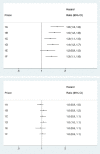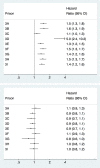Associations between prisons and recidivism: A nationwide longitudinal study
- PMID: 35580122
- PMCID: PMC9113604
- DOI: 10.1371/journal.pone.0267941
Associations between prisons and recidivism: A nationwide longitudinal study
Abstract
Objectives: To examine differences in recidivism rates between different prisons using two designs-between-individual and within-individual-to account for confounding factors.
Methods: We examined recidivism rates among 37,891 individuals released from 44 Swedish prisons in three security levels, and who were followed from 2006 to 2013. We used longitudinal data from nationwide registers, including all convictions from district courts. First, we applied a between-individual design (Cox proportional hazards regression), comparing reconviction rates between individuals released from prisons within the same security level, while adjusting for a range of individual-level covariates. Second, we applied a within-individual design (stratified Cox proportional hazards regression), comparing rates of reconviction within the same individuals, i.e., we compared rates after release from one prison to the rates in the same individual after release from another prison, thus adjusting for all time-invariant confounders within each individual (e.g. genetics and early environment). We also adjusted for a range of time-varying individual-level covariates.
Results: Results showed differences in the hazard of recidivism between different prisons in between-individual analyses, with hazards ranging from 1.22 (1.05-1.43) to 4.99 (2.44-10.21). Results from within-individual analyses, which further adjusted for all time-invariant confounders, showed minimal differences between prisons, with hazards ranging from 0.95 (0.87-1.05) to 1.05 (0.95-1.16). Only small differences were found when violent and non-violent crimes were analyzed separately.
Conclusions: The study highlights the importance of research designs that more fully adjust for individual-level confounding factors to avoid over-interpretation of the variability in comparisons across prisons.
Conflict of interest statement
The authors have declared that no competing interests exist.
Figures



Similar articles
-
Effectiveness of aggression replacement training in reducing criminal recidivism among convicted adult offenders.Crim Behav Ment Health. 2018 Dec;28(6):476-491. doi: 10.1002/cbm.2092. Epub 2018 Oct 16. Crim Behav Ment Health. 2018. PMID: 30328151
-
Violent criminal recidivism in mentally disordered offenders: a follow-up study of 13-20 years through different sanctions.Int J Law Psychiatry. 2013 May-Aug;36(3-4):250-7. doi: 10.1016/j.ijlp.2013.04.015. Epub 2013 May 11. Int J Law Psychiatry. 2013. PMID: 23672945
-
Zeroing in on violent recidivism among released prisoners.Lancet Psychiatry. 2016 Jun;3(6):493-4. doi: 10.1016/S2215-0366(16)30086-4. Lancet Psychiatry. 2016. PMID: 27262037 No abstract available.
-
Criminal recidivism rates globally: A 6-year systematic review update.J Crim Justice. 2023 Sep-Oct;88:102115. doi: 10.1016/j.jcrimjus.2023.102115. J Crim Justice. 2023. PMID: 38486817 Free PMC article. Review.
-
Substance Use and Recidivism Outcomes for Prison-Based Drug and Alcohol Interventions.Epidemiol Rev. 2018 Jun 1;40(1):121-133. doi: 10.1093/epirev/mxy004. Epidemiol Rev. 2018. PMID: 29733373
Cited by
-
Psychosocial determinants of recidivism risk among incarcerated individuals with a history of substance use: A systematic review.PLoS One. 2025 Jul 11;20(7):e0327810. doi: 10.1371/journal.pone.0327810. eCollection 2025. PLoS One. 2025. PMID: 40644474 Free PMC article.
References
-
- UNODC. HIV prevention, treatment and care in prisons and other closed settings: a comprehensive package of interventions. Vienna: United Nations Office of Drugs and Crime. 2013.
Publication types
MeSH terms
Grants and funding
LinkOut - more resources
Full Text Sources

